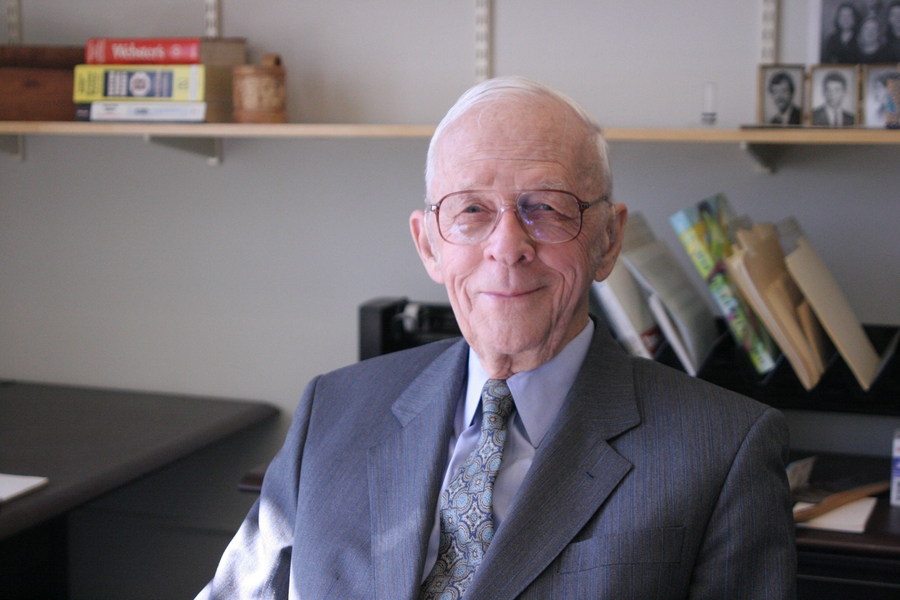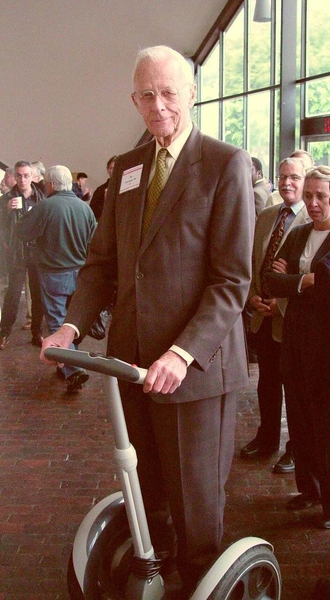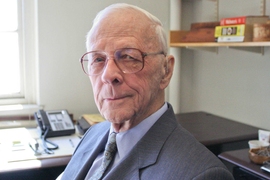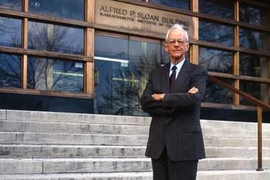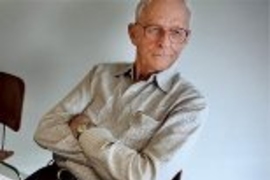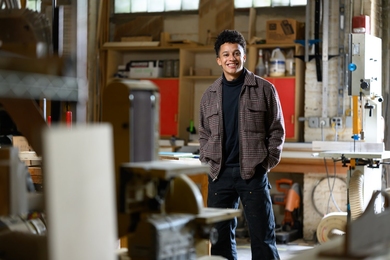Jay W. Forrester SM ’45, professor emeritus in the MIT Sloan School of Management, founder of the field of system dynamics, and a pioneer of digital computing, died Nov. 16. He was 98.
Forrester’s time at MIT was rife with invention. He was a key figure in the development of digital computing, the national air defense system, and MIT’s Lincoln Laboratory. He developed servomechanisms (feedback-based controls for mechanical devices), radar controls, and flight-training computers for the U.S. Navy. He led Project Whirlwind, an early MIT digital computing project. It was his work on Whirlwind that led him to invent magnetic core memory, an early form of RAM for which he holds the patent, in 1949.
MIT Sloan Professor John Sterman, a student, friend, and colleague of Forrester’s since the 1970s, points to a 2003 photo of Forrester on a Segway as an illustration of his work’s lasting impact.
“He really is standing on top of the fruits of his many careers,” Sterman said. “He’s standing on a device that integrates servomechanisms, digital controllers, and a sophisticated feedback control system.”
“From the air traffic control system to 3-D printers, from the software companies use to manage their supply chains to the simulations nations use to understand climate change, the world in which we live today was made possible by Jay’s work,” he said.
Systems dynamics: A new view of management
It was after turning his attention to management in the mid-1950s that Forrester developed system dynamics — a model-based approach to analyzing complex organizations and systems — while studying a General Electric appliance factory. An MIT Technology Review article explores how he sought to combat the factory’s boom-and-bust cycle by examining its “weekly orders, inventory, production rate, and employees.” He then developed a computer simulation of the GE supply chain to show how management practices, not market forces, were causing the cycle.
Forrester’s “Industrial Dynamics” was published in 1961. The field expanded to chart the complexities of economies, supply chains, and organizations. Later, he cast the principles of system dynamics on global issues in “Urban Dynamics,” published in 1969, and “World Dynamics,” published in 1971. The latter was an integrated simulation model of population, resources, and economic growth. Forrester became a critic of growth, a position that earned him few friends.
“Many businesses, government officials, and academics hated it,” Sterman said, “yet today, the collision between the finite resources of our planet and population and economic growth drives issues from climate change to deforestation, collapsing fisheries, resource conflict, and mass migrations.” Four of Forrester’s students would rely on his ideas to write “The Limits to Growth,” a 1972 book that helped to launch the field of global modeling and the sustainability movement around the world.
In many ways, system dynamics stands in opposition to the idea that a charismatic or talented leader can steer a wayward firm to success, a tension Forrester explained to MIT Technology Review.
“Very often people are just role players within a [company’s] system,” he said. “They are not running it; they are acting within it. This has not been a popular idea with people who think they are in charge … but in fact, unless they are knowledgeable in systems, they will fall into a pattern of doing what the system dictates. If they understand the system, they can alter that behavior.”
At MIT Sloan, Forrester created the Refrigerator Game, a supply chain simulation that teaches the principles of system dynamics. It was later dubbed the Beer Game and remains a popular exercise during student orientation.
“What made Jay so special is because of his background in digital computing, he saw, with the advent of the digital computer, the ability to do simulations that were both large-scale and practical,” said MIT Sloan Professor Nelson Repenning. “He appreciated that far before anyone.”
From the family ranch to MIT
All this from a boy who grew up working the family ranch.
“I’ve had several careers,” he told MIT Technology Review. “Starting with ranch hand.”
Forrester was born July 14, 1918 in Nebraska. He earned a bachelor’s degree in electrical engineering from the University of Nebraska in 1939. He arrived at MIT the same year as a graduate student in the School of Engineering, earning a master's in 1945. He joined what would become the MIT Sloan faculty in 1956 and retired in 1989.
“To me, Jay was MIT,” Repenning said. “He showed up to work on gunsights and radar mounts for the U.S. military, ended up playing a pioneering role in digital computing, and suddenly became a social scientist. I can’t imagine that happening anywhere else. It was the perfect match of a unique person [and institution].”
Sterman said Forrester had high standards as a teacher, but that submitting work to his rigorous inspection was rewarding.
“It was a great experience to have Jay mark up one of your papers with his red pen,” he said. “The way to learn the most from Jay was first of all to recognize that he was probably right and you were wrong, and secondly, to just be grateful for the gift of all that criticism, because everything you did after that was better.”
Forrester was married for 64 years to Susan (Swett) Forrester, who died in 2010. He is survived by a daughter, Judith; two sons, Nathan and Ned; four grandchildren, Matthew, Julia, Neil, and Katherine; and two great grandchildren, Everett and Faraday.
